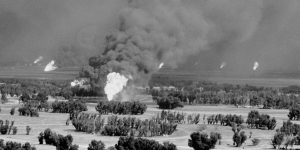
What Happened On June 26th?
On June 26, 1993, President Bill Clinton ordered a military strike against Iraq in retaliation for a plot to assassinate former President George H.W. Bush. This bold move showed the United States’ resolve to protect its leaders and assert its power on the global stage.
The Assassination Plot
In April 1993, Kuwaiti officials discovered a car bomb intended to kill former President George H.W. Bush during his visit to Kuwait. The bomb, hidden in a Toyota Land Cruiser, contained over 175 pounds of explosives. Investigations by both Kuwaiti and American intelligence agencies linked the plot to the Iraqi Intelligence Service (IIS). Several suspects, including two Iraqi nationals, confessed to involvement in the plan, with direct orders coming from the top levels of the Iraqi government.
President Clinton, then only a few months into his term, faced a challenge. The revelation of such a plot not only threatened the life of a former president but also tested Clinton’s resolve as a leader.
Operation Desert Strike
After confirming Iraq’s involvement, President Clinton and his national security team, including Secretary of Defense Les Aspin and National Security Advisor Anthony Lake, planned a swift response. They named the plan Operation Desert Strike, aiming to target the Iraqi Intelligence Service headquarters in Baghdad.
Advanced satellite technology allowed the U.S. military to gather real-time intelligence on the target. This technology ensured the precision and effectiveness of the strike.
The Strike
In the early hours of June 26, 1993, two U.S. Navy warships, the USS Chancellorsville and the USS Peterson, launched 23 Tomahawk cruise missiles toward the IIS headquarters in Baghdad. The attack aimed to minimize civilian casualties while delivering a powerful blow to the Iraqi regime’s intelligence apparatus.

The missiles struck their targets with precision, causing critical damage to the intelligence complex. While the immediate physical impact was substantial, the symbolic message was even more profound. The United States had demonstrated its capability and willingness to respond forcefully to threats against its citizens and leaders.
The use of Tomahawk missiles in this operation showcased advancements in U.S. military technology. These missiles could be programmed to follow complex flight paths and hit targets with remarkable accuracy.
Saddam Hussein, the then-President of Iraq, was the mastermind behind the assassination plot against George H.W. Bush. Hussein’s leadership of the Iraqi Intelligence Service, orchestrated the plot.
This operation against his regime was not just a response to the assassination attempt but also a clear message to Hussein about the consequences of such actions. Clinton’s decision to strike directly at the heart of Hussein’s intelligence apparatus was intended to cripple his ability to execute similar operations in the future.
Clinton’s Address
Following the successful operation, President Clinton addressed the nation. He stated, “I ordered this strike because we will not tolerate, and we will not allow, any form of terrorism against the United States.” Clinton’s address showed Americans that he highly valued national security and the protection of American interests worldwide.
The international community largely supported Clinton’s decision. Allies in Europe and the Middle East expressed solidarity, recognizing the need to combat terrorism with decisive action. However, some nations and organizations criticized the strike, arguing that it could escalate tensions in an already volatile region.
What A Presidential Message Could Do
The strike on the IIS headquarters had immediate and long-term effects. In the short term, it disrupted Iraqi intelligence operations and showcased the precision and effectiveness of American military technology. It also became a deterrent to other nations or groups contemplating similar actions against the United States.

In the longer term, the operation reinforced the United States’ stance against terrorism and emphasized the Clinton administration’s willingness to take bold actions to protect American lives and interests.
President Clinton & His Thoughts
The operation included a classified briefing provided to President Clinton by CIA Director James Woolsey, which detailed the risks and potential outcomes of the strike. This briefing underscored the gravity of the decision and the calculated risks involved.
In the years following the strike, Clinton often reflected on the decision. He later wrote in his memoir, “My Life,” that the operation was a defining moment in his presidency. It shaped his approach to dealing with international threats and reinforced his belief in the importance of decisive action.
The strike involved coordination with several intelligence agencies, including the National Security Agency (NSA), which provided crucial electronic intelligence that helped confirm the Iraqi plot and identify key targets within the IIS headquarters.
What The Presidential Strike Meant
The 1993 strike against Iraq showed how the United States would respond to threats against its leaders. It illustrated the ability of the U.S. to conduct precise military operations using advanced technology, and it demonstrated the nation’s resolve to act decisively in the face of terrorism.
President Clinton’s response to the assassination plot against George H.W. Bush made it clear that any threats to American lives would be met with forceful retaliation. The operation highlighted the evolving nature of military strategy and the increasing importance of intelligence and technology in modern warfare.

